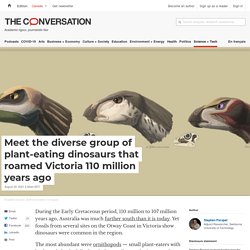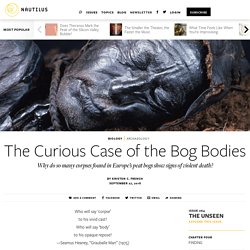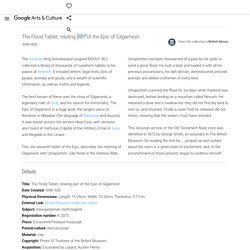

Meet the diverse group of plant-eating dinosaurs that roamed Victoria 110 million years ago. During the Early Cretaceous period, 110 million to 107 million years ago, Australia was much further south than it is today.

Yet fossils from several sites on the Otway Coast in Victoria show dinosaurs were common in the region. The most abundant were ornithopods — small plant-eaters with beaks and cheeks full of teeth. But until recently, it was unclear exactly how many species coexisted at the same time. So far, five ornithopod species have been named from the Cretaceous of Victoria.
There are three from the Otway Coast: Atlascopcosaurus loadsi, Diluvicursor pickeringi and Leaellynasaura amicagraphica; and two from the Bass Coast: Qantassaurus intrepidus and Galleonosaurus dorisae. The rocks exposed on the Bass Coast (and the fossils they contain) are around 15 million to 20 million years older than those on the Otway Coast. Eric The Red West Thanks to research led by my former student Ruairidh Duncan, we’re now in a better position to answer this question. A little help from technology. Uncovering Hidden Stories. How Humans Migrated Across The Globe Over 200,000 Years: An Animated Look. Coverage of the refugee crisis peaked in 2015.

Scientists reconstruct Ötzi the Iceman’s frantic final climb. A wounded—and possibly wanted—man, Ötzi the Iceman spent his final days on the move high up in the Alps until he was felled with an arrow to the back.

About 5,300 years later, archaeologists are still unraveling the mystery of his death. Now, a new analysis of mossy plant remains from the Iceman’s murder site may reveal details of his frantic, final climb. Since 1991, when hikers in the Ötztal Alps discovered his frozen, naturally mummified body near the border between Italy and Austria, researchers have counted more than 60 tattoos on Ötzi's skin and shown that he was wearing a leather coat stitched together from the hides of several sheep and goats. They recently found his lost stomach, and from its contents, learned that Ötzi was murdered just an hour after eating a final meal of dried ibex and deer meat with einkorn wheat. A mossy mystery Flat neckera was found in relatively large quantities at the site, often stuck to Ötzi's clothing. Why So Many Bog Bodies Show Signs of Violent Death. Who will say ‘corpse’ to his vivid cast?

Who will say ‘body’ to his opaque repose? —Seamus Heaney, “Grauballe Man” (1975) One Saturday in the spring of 1950, brothers Viggo and Emil Højgaard from the small village of Tollund, in Denmark, were cutting peat in a local bog when they uncovered a dead man. He looked as though he had only just passed away. 40,000-Year-Old Symbols Found in Caves Worldwide May Be the Earliest Written Language. We may take it for granted that the earliest writing systems developed with the Sumerians around 3400 B.C.E.

The archaeological evidence so far supports the theory. But it may also be possible that the earliest writing systems predate 5000-year-old cuneiform tablets by several thousand years. And what’s more, it may be possible, suggests paleoanthropologist Genevieve von Petzinger, that those prehistoric forms of writing, which include the earliest known hashtag marks, consisted of symbols nearly as universal as emoji. The study of symbols carved into cave walls all over the world—including penniforms (feather shapes), claviforms (key shapes), and hand stencils—could eventually push us to “abandon the powerful narrative,” writes Frank Jacobs at Big Think, “of history as total darkness until the Sumerians flip the switch.”
She discovered 32 signs found all over the continent, carved and painted over a very long period of time. Via Big Think Related Content: Ancient Earth globe. Bradshaw Foundation - Journey of Mankind. Who were our ancestors?

From where did we originate? If we came out of Africa, what factors governed our routes? And when? Now finally this interactive genetic map, created collaboratively with Professor Stephen Oppenheimer, based on his book 'Out of Eden' / 'The Real Eve', reveals an exciting journey of opportunity and survival, confirmed by genetic science and documented by ancient rock art, we look in depth at the Journey of Mankind and investigate how modern science has helped shed light on this monumental exodus. * The interactive map is not currently available for mobile and tablets devices.
The Flood Tablet, relating part of the Epic of Gilgamesh - Google Arts & Culture. The Assyrian King Ashurbanipal (reigned 669-631 BC) collected a library of thousands of cuneiform tablets in his palace at Nineveh.

It included letters, legal texts, lists of people, animals and goods, and a wealth of scientific information, as well as myths and legends. Ancient History Interactive: Iron Age Life. Handy Man - Tools - Early Humans for Kids. Early man did not have sharp claws or strong sharp teeth.

He was not larger or stronger than other animals. He could not run like deer or antelope. So how did early man survive? He had to use the things that animals did not have, reason and invention. Early man invented and created stone and bone weapons and tools. Prehistoric Humans - World History For Kids. Show me - prehistory games, activities and resources for kids from UK museums and galleries.